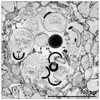Uncommon pollen walls: reasons and consequences)
- PMID: 28904424
- PMCID: PMC5593117
Uncommon pollen walls: reasons and consequences)
Abstract
The mature pollen wall of gymnosperms and angiosperms consists in principle of two fundamentally different layers, the complex, thick sporopolleninous exine and the homogeneous, thin, single-layered pectocellulosic intine. In angiosperms, the typical exine is usually formed by a tectum, columellae, a foot layer, and an endexine. An exine reduction (minimally up to the complete absence) occurs in many unrelated seed plants, without consequences for pollen viability. The intine sometimes also deviates from its common form, being either extremely thick or appearing two- or even three-layered. Environmental factors or developmental constraints are highlighted as being responsible for the various deviating exine and intine forms.
Pacini e & hesse m 2012 unkomplette pollenwand – gründe und konsequenzen: Die fertige Pollenwand der Gymnospermen und der Angiospermen besteht im Prinzip aus zwei fundamental verschiedenen Lagen, aus der komplexen, dicken und sporopolleninhältigen Exine, und der homogenen, dünnen, einschichtigen und überwiegend zellulosehältigen Intine. Bei Angiospermen ist die typische Exine aus einem Tectum, aus Columellae, aus einem Foot Layer und zumeist noch aus einer Endexine geformt. In vielen, nicht miteinander verwandten Angiospermen (seltener bei Gymnospermen) is die Exine mehr oder weniger stark reduziert, was allerdings keinen Einfluß auf die Keimungsfähigkeit des Pollens hat. Auch die Intine weicht manchmal von ihrer üblichen Ausbildung ab, ist entweder auffallend dick oder zwei bis dreischichtig. Sowohl Umweltfaktoren als auch embryologisch und entwicklungsgeschichtlich bedingte Hemmungen sind für die abweichenden Exine- und Intineformen verantwortlich.
Keywords: callose; environmental constraints; exine; harmomegathy; intine; pollen; water content.
Figures



References
-
- Ackerman KD. Convergence of filiform pollen morphologies in seagrasses: functional mechanisms. Evolutionary Ecology. 1995;9:139–153.
-
- Blackmore S, McConchie CA, Knox RB. Phylogenetic analysis of male ontogenetic program in acquatic and terrestrial monocotyledons. Cladistic. 1987;3:333–347. - PubMed
-
- Blackmore S, Wortley AH, Skvarla JJ, Rowley JR. Pollen wall development in flowering plants. New Phytologist. 2007;174:483–498. - PubMed
-
- Blokker P, Schouten S, de Leeuw JW, Sinninghe Damasté JS, van der Ende H. Molecular structure of the resistant biopolymer in zygospore cell walls of Chlamydomonas monoica. Planta. 1999;207:539–543.
Grants and funding
LinkOut - more resources
Full Text Sources
Miscellaneous
